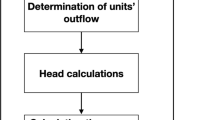Abstract
Unit commitment problem is a complex decision-making process which involves the scheduling of generators over a set of time periods to satisfy system load demand, water demand, system reliability, operational, and security constraints. Mathematically, this is a nonlinear, nonconvex, high dimensional, and large-scale optimization problem over mixed integer variables. Additionally, for a short-term unit commitment problem such as hourly or daily scheduling of generators, the operator needs to run the model in realtime. The operator should have immediate access to information concerning which units should be operated when emergency situations arise or how to schedule around planned maintenance of units. Mixed integer programming (MIP) model is developed to solve the unit commitment problem. The MIP model developed in this study consists of three sub-models: PLANT-DY-W, PLANT-GO-W, and PLANT-ST-W. It provides generation control tool that regulates the hydropower system while improving powerplants efficiency. Also, it automates and improves the unit schedule process for the powerplants. To demonstrate the capabilities of the unit commitment models a case study was carried out on a hydropower system in Lower Colorado River Basin.
Similar content being viewed by others
References
Baldick, R. (1995). “The generalized unit commitment problem.”IEEE Transactions on Power Systems, 10(1), 465–475.
Guan, X., Luh, P.B., and Zhang, L. (1995). “Nonlinear approximation method in Lagrangian relaxation-based algorithms for hydrothermal scheduling.”IEEE Transactions on Power Systems, 10(2), 772–778.
Kasangaki, V.B.A., Sendaula, H.M. and Biswas, S.K. (1995). “Stochastic Hopfield artificial neural network for electric power production costing.”IEEE Transactions on Power Systems, 10(3), 1525–1533.
Kazarlis, S. A., Bakirtzis A.G. and Petridis V. (1996). “A genetic algorithm solution to the unit commitment problem.”IEEE Transactions on Power Systems, 11(1), 83–92.
Kothari, D.P. and Ahmad A. (1995). “An expert system approach to the unit commitment problem,” Energy Convers.Management, 36 (4), 257–261.
Lauer, G.S., Sandell, N.R., Bertsekas, D.P., and Posbergh, T.A. (1982). “Solution of large-scale optimal unit commitment problems,”IEEE Transactions on Power Apparatus and Systems, 101(1), 79–86.
Lowery, P.G. (1966). “Generating unit commitment by dynamic programming.”IEEE Transactions on Power Apparatus and Systems, 85(5), 422–426.
Pang, C.K. and Chen, H.C. (1976). “Optimal short-term thermal unit commitment.”IEEE Transactions of Power Apparatus and Systems, 95(4), 1336–1346.
Peterson, W.L. and Brammer, S.R. (1995). “A capacity based Lagrangian relaxátion unit commitment with ramp rate constraints.”IEEE Transactions on Power Systems, 10(2), 1077–1084.
Ruzic, S. and Rajakovic, N. (1991). “A new approach for solving extended unit commitment problem”,IEEE Transactions on Power Systems, 6(1), 269–277.
Snyder, W.L. Jr., Powell, H.D. Jr. and Rayburn J.C. (1987). “Dynamic programming approach to unit commitment.”IEEE Transactions on Power Systems, 2(2), 339–350.
Van den Bosch, P.P.J. and Honderd, G. (1985). “A solution of the unit commitment problem via decomposition and dynamic programming”,IEEE Transactions on Power Apparatus and Systems, 104(7) 1684–1690.
Virmani, S., Adrian, E.C., Imhof, K. and Mukjerjee, S. (1989). “Implementation of a Lagrangian relaxation based unit commitment problem.”IEEE Transactions on power Systems, 4(4), 1373–1380.
Author information
Authors and Affiliations
Additional information
The manuscript for this paper was submitted for review on February 18, 1998.
Rights and permissions
About this article
Cite this article
Yi, J. Mixed integer programming approach to optimal short-term unit commitment for hydropower systems. KSCE J Civ Eng 2, 335–346 (1998). https://doi.org/10.1007/BF02830483
Issue Date:
DOI: https://doi.org/10.1007/BF02830483




